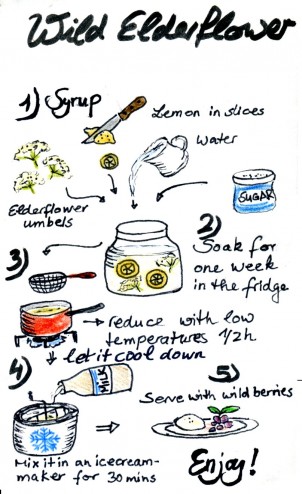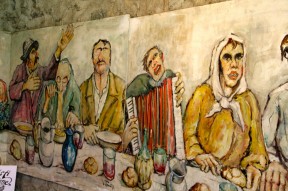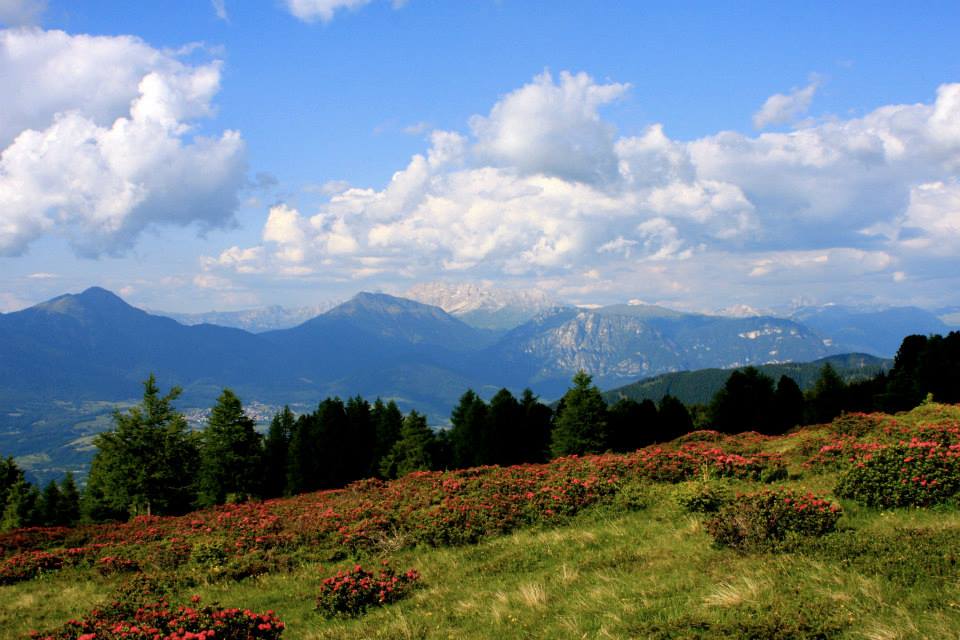A culinary trip in search of authenticity
What is authentic food? This is one of the key questions that I’ve been asking myself since I started studying “Food Culture and Communications – Human Ecology and Sustainability” at the University of Gastronomic Sciences in Pollenzo.After one month in class we went on our first “Study field trip” to make practical experiences. Destination: Trentino.
Meeting people from small-scale producers up to head managers of world-wide acting corporations. What a great opportunity to get closer to my own definition of authenticity and to learn about the ways how sustainability can be understood in the world of gastronomy. Of course all the way from the agricultural production to the plate.
Arriving in Trento we visit “The Palazzo Roccabruna – The Home of Trentino Products”. There we get an introduction to the autonomous province of Trentino by Adriano Zanotelli the head of “The observatory of products of Trentino”. The province in the north of Italy close to the Austrian border consists of 70% of mountains which create a pattern of many u-shaped valleys which developed through the erosion of the glacial ice sheets. Generally the climate varies from mediterranean in the south up to alpine in the north. But it also changes between the different valleys and how they are opposed to wind and sun. Due to this the typical products of the region are as manifold as its territories. As some examples show on the map above .
Wine in Trentino
One beverage two approaches
We are driving through the Vall‘ Adige plenty of vineyards are clambering up the slopes until the edge of the forests that cover most of the Mountains. Trentino is a wine region with 10.000 hectares of vineyards from 70 meters altitude up to 800 meters.
Ferrari Spumante
The fresh pre-alpine climate with cold nights and warm days is perfect to grow Chardonnay and Pinot Grigrio with a high percentage of acidity which is the base for the so-called TRENTODOC Spumante (DOC- Controlled Designation of Origin) the Trentinos Champagne. At the beginning of the 20th century Giulio Ferrari brought the Chardonnay variety and the “Metodo Classico” (Métode Champegnoise) – as described on the picture above – from the Champagne region in France to his home region Trentino and started the Spumante production with its company Ferrari. The denomination of TRENTODOC furthermore includes strict rules based on the territory such as the typical cultivation in pergolas.
Today Ferrari is run by the Lunelli family that took over the in1952. With about 720 hectars (600 ha from partner wine-growers) they produce about 5 million bottles of high quality TRENTODOC with an aging range from two to ten years. Arriving at the Ferraris visitor-center we are entering a classy hall with pictures of “Very Important People” celebrating with Ferrari. Nothing reminds me on the actual growing of the wine. This comes after visiting the huge and impressive wine cellar, when we watch an image video with romanticised fieldwork in yellow reddish autumn light. Excluding any possible problems which appear during the complex procedure of growing wine. In his speech about his business Marcello Lunelli the vice president of the company explains us how the right marketing made Ferrari so successful. He presents us the marketing concept promoting Ferrari as “the Italian Art of Life” all over the world5. On the other hand he speaks about his recent struggle to strengthening the distribution in Trentino and the identification with the region. Which is not astonishing me when I see the advertisement with a sexy woman after a party in Venice which is for me disconnecting the product from it’s origin. Never the less the straw yellow Perlage from 2006 we taste after the speech is an excellent sparkling wine with an intense bouquet and the fresh and fruity note of a ripe apple.
Castel Noarna
A way different experience awaits us at the end of the same day, with the wine producer Marco Zani at his vineyard “Castel Noarna”. His father bought this piece of land of about six hectares with an old castle on it and used to produce for Ferrari. At one point about seven years ago Marco Zani discovered bio-dynamic wine and that it can have really good quality. He learned all about this special wine-making from the right work in the vineyard until the process of spontaneous fermentation. And unfortunately the old man who helped him in the cellar still had some similar traditional knowledge which seemed to be lost while the modernization of the wine production in the last decades. Finally he converted the production into bio-dynamic.

For that reason he for example stopped using the conventional chemical pesticides mixture which has to be applied every two weeks preventively. Instead he uses copper and sulphur right after it has rained to protect the leaves from mildew. He’s digging a hole to let us understand the role of the soil, its structure and the important loosening effect of green manure that is planted in between the wine rows. We get a glimpse of what it means to be a winegrower. We are basically experiencing the things we have missed in the morning at Ferraris. And in the end we taste these honest wines in the ballroom of the castle with a feeling like shifted back into the 11th century.
A week of conviviality
Favourite restaurants
Besides tasting wine we obviously had to eat and what is such a trip without the conviviality of the gastronomes of the region and tasting their interpretation of the traditional kitchen and their connection to their territory. In the following part I will portrait three restaurants which not just served excellent menus but represented concepts of authentic cuisine in three different individual ways.
Locanda delle tre chiavi in Isera
Sergio Valentini – the communicator
The Locanda delle tre chiavi is located in the little village Isera in the middle of the vineyards of Vallagarina. For fifteen years, Sergio Valentini has been running this place with a beautiful ambience where people come together and which makes them feel comfortable. As the current president of “Slow Food Trentino – Alto Adige”, and its Presidi his philosophy is: “I want to give value to the local community, and tell my guests the story from the people, who make the food. And in this way support them in their work, especially the young ones.” Following this aim there’s a detailed list in the menu of all of his producers, suppliers and the “Presidio” products he serves. In which you can also find a description of the restaurant philosophy formulated in twelve acts of eating slow.
Furthermore he knows about his responsibility for the environment as a gastronome for that reason the “Locanda Tre Chiavi” is certified by the province to be an Eco-Restaurant (“Ecoristorazione Trentino”). This means besides the priorly organic and local food provisioning, that they have to reduce waste, save energy and water, put the priority on “green” non-food products and finally inform clients about the
implementation of environmental good practices and involve them in them. Following all these obligations, day by day, is not the easiest way of running a restaurant. But in the end he certainly says “it is much more rewarding than the conventional way.”
Albergo e Ristorante Nerina
From field to plate
In the middle of the Val di Non we are having lunch at the hotel and restaurant Nerina. We are sitting in a guest-room with the old fashion charm of a hotel from the 1960s in the alpine-regions of Europe. Sandro di Nuzzo welcomes us and tells us the story of this hotel that his parents Nerina and Francesco started in 196910. As the “farmer” of the family he shows us the garden in the back of the house and the field 50 metres down the road, both supply most of their vegetable and staple needs. Nerina is a family business all working together and sizing the restaurant and hotel after the amount of work they can do. There’s no aim to grow and they are satisfied with the way it is. Always trying to make as much as they can by themselves. Such as the Mortandela from Val di Non one of the Starters we have. A Salami from a suckling pig that was usually made from the families in the valley. For this the meat is finely grind and after mixing it with spices brought into a roll like balls and wallowed in buckwheat flour. After this it gets smoked on a wooden board and has to ripen at least 25 days. The salami is either eaten raw or cooked and has a mild but smoky flavour. Right after our lunch we pass by the local butcher where they buy the meat. A small artisan production and when Sandro plans to make his products he chooses which animal is going to be used and his butcher will freshly slaughter and prepare it for him.
Costa Salici
The wild taste of the season
Maurizio Tait is the chef in his alpine rustic restaurant at the ed
ge of the forest right above Cavalese in the Valle di Fiemme. In his menu he serves a taste of the “wild” Trentino. The menu starts with “Insalata Salmerino” (smoked samlet salad) and a “raw deer tatar” with home made “cheese crackers”. The second is a traditional Polenta from corn and buckwheat with a ragout of self collected mushrooms such as porcini and a fondue cheese sauce.

But if this hasn’t been enough it was the dessert that gave me this very deep gut feeling that this menu honestly represents the season. I immediately recognised this floral mild aroma in the sorbet that we got and I fell in love straight away. A sweet but light experience with the simple sourness of fresh lemon. An elderflower sorbet that melts on the tongue smoothly and gives you this very special floral sensation of the beginning summer, when you smell the sweetness of wild elder trees blooming all along the fields. Topped with an arrangement of wild berries it was just delicious. But as you can see on the recipe to the right the ingredients are so simple. That leads me to the last point about what makes a kitchen and its gastronomes authentic to me: The willingness to share recipes, ideas and with the passion for food. As an autodidactic chef Maurizio Tait gives cooking courses13 and he was more than happy to tell me the “open secret” of his sorbet.
Arts in a medieval village
La Casa degli artisti

Canale is a little 13th century village, in the community of Tenno, that tightly fits on the mountain slope about 600mts above sea level just ten kilometres up from the Garda lake. There are plenty of narrow tiny streets with arches, closely packed houses looking like that they are one. On this sunny day the air is cool in here and filled with the humidity of century old stonewalls.
In 1967 when a lot of people had left the village to the next bigger city the hobby artist “Giacomo Vittone” came with his bike to paint here. Further on he bought one of the abandoned houses for a reasonable price and founded “La casa degli artisti” “The artists house” together with friends. After the renovating it was an open place for artists to come and paint for a week in an inspiring environment with a beautiful view on the end of the Valle di Sarca. As exchange they left a painting there for the internal exhibition.
Today the house is run by the communities of Tenno, Arco and Riva del Garda. It is a meeting place for contemporary artists where seminaries, courses, exhibitions, study visits and cultural events take place. With the exhibition halls under the roof top, a kitchen and the simple guest-rooms on the second, course rooms on the first floor and an art garden surrounding it, this house has the enriching combination of hospitality and cultural creativity.
Alpine milk
La Malga Sass
The last extraordinary experience of our trip goes up on almost 2000 metres of altitude visiting the “Malga Sass” (Chalet Sass) for one night. Here we meet the alpine herdsman just 17 years old who herds the 27 Grigio Alpina cows (Slow Food Presidio) for the summer season (june to october) when they are on the “Malga”. Still going to agricultural school he roughly explains us the daily routine like an old farmer who worked with heart and soul for all his life:
- Gathering the herd and milking in the morning
- Bringing the milk down to the artisanal cheese dairy of the Agritur Fior di Bosco in Valfloriana
- Helping out in the cheese production
- Cutting grass for the hay in the winter season
- Helping out on the farm in Valforiana
- Maintaining the shed on the Malga
- Gathering and milking the cows in the evening
In the end we ask what he wants to do in the future and he says with total conviction: “I want to be a farmer. This is my life.” On a little hike to a plateau above the tree limit we have a stunning panorama on the alpine mountain range. Breathing this clear air with the smell of green fresh grass, herbs and flowers, I can immediately understand why the cows like it here.

And I experience the difference between the sensations of alpine milk and the one coming from cows standing in the shed all day long eating concentrated feed from the other side of the world. After a warming nourishing risotto in the cosy guest room of the hut we go to sleep with the jingle of the cows bells playing the good night song. And the world seems to slow down for a moment.
